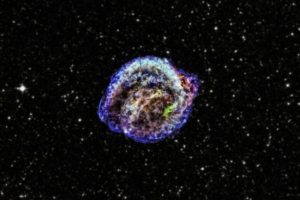A study on the processes responsible for the acceleration of particles in shocks. The study: “Individual particle approach to the diffusive shock acceleration. Effect of the non-uniform flow velocity downstream of the shock” of O. Petruk (INAF-OAPA) appeared on A&A

Our planet is constantly bombarded by highly energetic particles known as ‘cosmic rays‘. The spectrum of cosmic rays up to energies of 1015 electronvolts (eV) is formed by the sources in our Galaxy, while particles with observed energies up to 1021 eV should have extra-galactic origin. The cosmic ray spectrum follows a power law, meaning that the flux of particles with a given energy decreases rapidly with increasing energy, following a power law with an exponent ranging from -2.7 to -3.0.
Shocks that can form in specific astrophysical objects, such as supernova remnants, have been known since the late ’70s to be responsible for the acceleration of cosmic rays. In shocks, certain properties of the medium through which the shock propagates, such as density, temperature, and velocity, change rapidly. Moreover, shocks are characterized by diffusion phenomena involving the magnetic field, which can increase the energy of particles, thus producing cosmic rays.
This process is actually quite complex, depending on various properties of the shock and of the medium through which the shock propagates. For example, measurable effects on the energy spectrum of cosmic rays can arise from spatial non-uniformity in the plasma velocity as upstream as downstream of the shock.
In the study titled “Individual particle approach to diffusive shock acceleration: Effect of the non-uniform flow velocity downstream of the shock“, recently published in the journal Astronomy and Astrophysics, the astronomers O. Petruk (INAF – Astronomical Observatory of Palermo) and T. Kuzyo (National Academy of Sciences of Ukraine) present an analytical solution for the momentum distribution of accelerated particles, which takes into account such spatial non-uniformity. This solution illustrates how the spectrum of cosmic rays, along with specific observables such as the radio emission spectrum, varies during the evolution of the supernova remnant.
Initially, the mathematical description of particle acceleration by the shocks was suggested in two alternative approaches, by solving the kinetic equation and by consideration of probabilities. However, besides the fact that the second approach is more intuitive for understanding, almost all known results on generation of cosmic rays were obtained by solving equations. The second approach is introduced in order to tackle complicated problems like effects from spatial plasma non-uniformity.
The cover image (click here to view it in its entirety) displays an X-ray image captured by the NASA satellite Chandra of the supernova remnant SN 1604, also known as the Kepler supernova remnant, one of the remnants where cosmic ray acceleration is studied.
Mario Giuseppe Guarcello ( follow mariospiegacose) ( mariospiegacose) ( follow mariospiegacose)
Follow the Astronomical Observatory of Palermo on Facebok and on Instagram
Subscribe the Youtube channel of the Astronomical Observatory of Palermo
